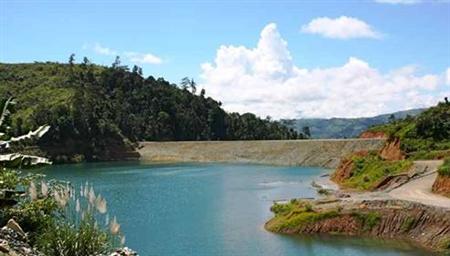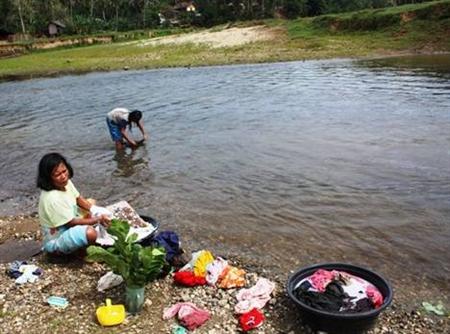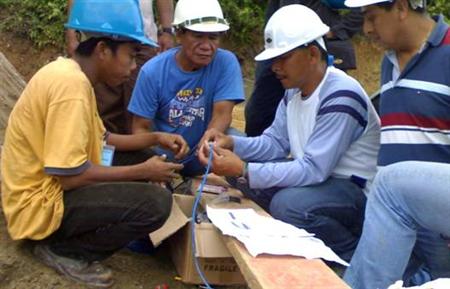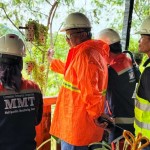TVIRD Canatuan’s Sulphide Dam `demonstrates capability of mining companies to protect the environment’
From a distance, this body of water looks like a small lake in a lush valley. The scene may even pass for a mountain resort where grasses, shrubs and trees abound all around. Located in a secluded area, the view becomes even more breathtaking during early mornings when the first rays of the sun begin to spread through the surrounding hills. The “lake” is actually an impoundment facility for tailings – wastes from the copper-zinc mining operations of TVI Resource Development Philippines, Inc. (TVIRD) in the mountains of Canatuan in Siocon, Zamboanga del Norte. Company personnel call the facility Sulphide Dam.

|
The TVIRD Canatuan Sulphide Dam Impoundment can hold nearly three million cubic meters of mine tailings.
|
Even during workdays, the Sulphide Dam area is quiet. Built in stages during a three year period, the dam was designed and reviewed by international engineering consultants following very stringent design criteria. Construction however was accomplished by an all-Filipino crew, many of whom come from the host town.
“This dam definitely looks like a lake. It does not look like an impoundment for wastes at all,” says Joseph Arnel Deliverio, executive editor of a weekly newspaper circulating in the neighboring town of Ipil, Sibugay Province. He and the 19 members of the Sibugay Press Club who went on a tour of TVIRD’s mine site recently were “simply amazed” by what they saw.
Edilberto Nercuit, TVIRD Canatuan Civil Engineering Services (CES) manager, began building the Sulphide Dam in November 2007. He and his 50-man crew of skilled workers had to work 24/7 until what he refers to as “Stage 3” of the construction work was completed last March 14. Now with a height of 70 meters, the impoundment can hold nearly three million cubic meters of tailings with the potential of increasing the capacity to nearly five million cubic meters in the future.

|
TVIRD’s Jay Nelson and Nilda Callora (left and center) and Siocon’s Siegfred Bueser both agree that the Sulphide Dam has contributed tremendously to the protection of the environment around the company’s copper-zinc mining operations in Zamboanga del Norte.
|
Tailings generated by the mill and process plant are continuously transported by pipeline to the impoundment for containment. TVIRD Environment Manager Nilda Callora says that following the conditions set forth by the company’s Waste Water Discharge Permit, TVIRD is allowed to discharge the equivalent of nearly 2,500 tonnes of tailings from the Sulphide Plant daily in conformity with the Philippine Clean Water Act of 2004.
Siegfred Bueser, a Siocon resident and member of the Multi-Partite Monitoring Team (MMT) representing the town’s farmers association believes TVIRD’s Sulphide Dam demonstrates the capability of big mining companies to protect the environment. He relates that during the time when small-scale miners operated in Canatuan in the 1990’s until 2002, the Canatuan and Cusan Creeks were heavily polluted with mine tailings laden with mercury and cyanide. The two creeks are tributaries of the Lituban River that flows into the Siocon River and then into Siocon Bay; one of Zamboanga del Norte’s important fishing grounds.



|
Top photo, Siocon remains one of Zamboanga del Norte’s top rice producing towns. Middle and bottom photos show children and women enjoying and using the Lituban River’s clean waters. Water from Canatuan and Cusan Creeks are upstream tributaries of the Lituban River.
|
“I still vividly remember how polluted these creeks were,” Bueser adds. “The level of contamination can be seen in documents of the offices of the Environment Management Bureau and the Department of Environment and Natural Resources (DENR) in Region 9. The levels of contamination were way beyond tolerable levels.
“Moreover, siltation at Lituban River was heavy and there was rampant cutting of natural grown trees that were used by small scale miners in their underground tunnels,” he continues. “There was also a breakdown in the peace and order situation; Canatuan became the haven of men with dubious origins.”
TVIRD’s Sulphide Dam, Bueser stresses, has contributed tremendously to the protection of the town’s bodies of waters. “The MMT is religiously monitoring the creeks and rivers surrounding the mine site to assure Siocon residents of a continuous supply of clean water for our farm irrigation system and fishponds. As a farmer, I want to maintain my towns’ record as one of the Zamboanga del Norte’s top rice producer. We cannot do that if we do not have a continuous supply of clean water that comes from water tributaries, among them the Canatuan and Cusan creeks.”

|
Ed Nercuit (second from right) and his men during the early stages of the Sulphide Dam construction. “Leaving a good name and clean bodies of water are the legacies that I wish to leave behind,” says Nercuit.
|
Jay Nelson, TVIRD Vice President for Environment and Civil Works, points out that while the Sulphide Dam is similar in design and construction to the Gossan Dam – TVIRD’s tailings containment facility during the gold-silver phase of its operations in Canatuan — the operational aspects between the two dams are different. “In the Gossan Dam, the tailings were pumped into the impoundment as slurry where they remain. Water, which is part of the slurry, eventually evaporates and the tailings surface dries up over time. In time, the exposed tailings surface will be rehabilitated as grasslands, forest areas or turned into a cash crop plantation style agricultural area.”
“In the Sulphide Dam, copper and zinc tailings will remain in a non-oxidized state to avoid generation of acid mine drainage,” he adds. “As such, the Sulphide tailings must be protected from contact with air, thereby preventing initiation of the oxidation process. Thus, we maintain a constant water cover over the tailings and operating the impoundment as a continuous water impoundment,” Nelson explained.
Besides the safe containment of tailings, the dam and impoundment also trap and contain the soil and sediment eroded from the exposed mine area. This is key to preventing siltation and water quality problems within the Lituban and Siocon Rivers downstream.
Construction of Stage 4 of the Sulphide Dam is anticipated to commence next year. When completed, the impoundment will have the capacity to contain nearly four million tonnes of tailings.
Nercuit, for his part, assures all stakeholders of the structural integrity and stability of the dam. “I am from Siocon. My family lives in Siocon. I love my hometown and my townmates so I must protect whatever rich resources that it has for future generations of Sioconians, which will include my children and my grandchildren. Leaving a good name and clean bodies of water are the legacies that I wish to leave behind.” (Lullie Micabalo)



